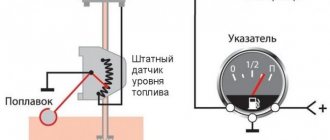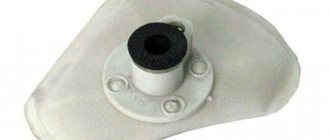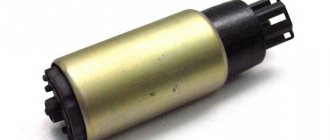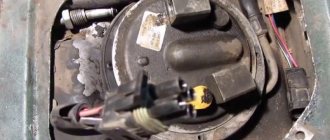Cleaning the fuel pump is a fairly urgent procedure that must be carried out when the following symptoms appear:
- Difficulty starting the engine with the starter;
- reduction in vehicle acceleration dynamics;
- jerking when pressing the gas pedal sharply;
- floating speed and sluggish engine response;
- the engine stalls in transition modes after pressing the accelerator, etc.
In some cases, when you press the gas, the car practically does not accelerate, overcomes inclines with great difficulty, and does not overtake. There may be several reasons for such a malfunction, but often the problem is localized in the fuel pump area. Next, we will consider issues related to the electric fuel pump, which is installed in the gas tank of injection cars.
We also recommend reading the article on checking the fuel pump. From this article you will learn how to diagnose the fuel pump of gasoline cars yourself based on the pressure in the fuel rail.
Symptoms of a clogged fuel filter
To protect the injectors and piston group from contamination and corrosion, it is necessary to thoroughly clean the incoming fuel from foreign particles, moisture and resins. This function is performed by a filter element that is installed between the tank and the pump.
The most common signs of a clogged fuel filter are high fuel consumption and reduced engine power, so the layer must be changed regularly.
Causes of a clogged fuel filter
The reasons for filter contamination are:
- low quality gasoline or diesel fuel;
- penetration of water into the tank with subsequent formation of ice crystals at low ambient temperatures;
- surface corrosion with release of metal particles and oxides;
- accumulation of resins and foreign impurities from oil and additives;
- accumulation of dirt and bottom sediments in the fuel tank;
- very dusty air, frequent off-road trips.
Pump operation and malfunctions
From the name you can understand that the fuel pump supplies fuel from the tank to the engine injectors. Accordingly, if the unit is faulty, then there will be no gasoline injection, and the power unit will not start working. There are options for injector and carburetor. The VAZ 2110 is equipped with an injector; therefore, the fuel pump must be suitable for this system. If the “ten” was modernized by installing a carburetor, then the unit will have to be taken out of stock. The unit is located in the fuel tank - under the left rear door, the electrics go under the rear row seats.
It is quite simple to understand that there are faults in the pump or its network:
- The car won't start. There are many reasons for this malfunction, but before performing a full diagnosis, you need to check whether the pump mesh is clogged or clogged.
- There are noticeable jerks in first gear. There are also many options here, but one of them is a non-working fuel pump.
Self-diagnosis
Filter diagnostics include assessing engine performance during operation, measuring fuel pressure and visual inspection. Measurements are taken through the ramp fitting, which distributes fuel to the injectors.
- hose with internal diameter 9 mm;
- fastening clamp;
- a device for determining gasoline pressure or a pressure gauge with a value range of 7-10 bar.
A special device can be purchased at a car store. The pressure gauge is connected to the hose and tightened securely with a clamp. To ensure the tightness of the contact, sanitary flax is used. The hose is connected to the fuel pressure fitting, after first removing the plug from it and removing the nipple.
After this, measurements are taken in various engine operating modes (at idle, after starting, with the drain tube pinched). The indicator after turning on the ignition should be at least 3.8-4 bar.
After the measurement, you need to turn off the engine and wait 20-30 minutes for the regulator to gradually reduce the pressure in the ramp. After this, disconnect the pressure gauge and reinstall the nipple and plug.
Replacing the fuel pump motor
The reason for replacing the fuel pump module motor is low gasoline pressure or sudden changes in pressure, which is recorded by a pressure gauge during the diagnostic process. Also, the imminent failure of the motor is indicated by the fact that the fuel pump is humming or whistling.
In this case, it is often possible not to change the pump assembly, which will save money. The device must be removed (similar to the situation with cleaning or replacing the mesh filter), after which it is disassembled. The motor itself is replaced and can be purchased separately. The housing and fuel level sensor can be left from the old fuel pump. At the same time, it is recommended to replace the gas pump gasket and other rubber seals, which are not designed for re-installation after removal, that is, they are disposable.
The first symptoms of a dirty fuel filter depending on the engine type
The degree of influence of the filter on engine operation depends on its type. Carburetor gasoline engines practically do not react to contamination of the cleaning layer. Minor changes can only be observed in the power and stability of the internal combustion engine.
The injector is more demanding on the pressure in the fuel line, so a decrease in filter capacity is immediately manifested by a drop in engine power. The most obvious symptom becomes at high speeds.
Motors that run on diesel fuel are the most sensitive to foreign particles and impurities. Their power and stability of operation directly depend on the level of pressure in the fuel line. When it decreases, startup delays and sudden jerks while driving are observed. In some cases, the engine turns on only after several attempts.
The sensitivity of engines to pollution is largely due to their requirements for the degree of fuel purification. Filter elements for diesel engines should not allow particles larger than 4-5 microns to pass through, for injection engines - 10 microns, and for carburetor engines - 20 microns.
The main signs of a clogged fuel pump filter
The main signs of a clogged layer in front of the pump are a decrease in vehicle power, loss of control stability and increased failures when starting the engine. In the initial stages, these symptoms only appear under certain conditions (such as driving uphill, accelerating, or idling), but over time the problem begins to worsen.
Reduced engine power
A decrease in engine power when the filter is dirty is due to the fact that the fuel pump and cylinder do not receive enough fuel. In this case, under increased load, the engine begins to turn off and stall. Sometimes the power of the power unit is not even enough to start.
The engine runs rough at idle
A decrease in pressure in the supply system may be accompanied by uneven idling, spontaneous shutdown and delayed re-ignition of the engine.
Violation of the functional stability of the engine is caused by a poor air-fuel mixture.
Increased fuel consumption
When starting with clogged filters, the internal combustion engine and pump experience increased load, and the composition of the fuel-air mixture deviates greatly from the optimal one. This affects fuel consumption and the wear rate of parts.
Signs of a clogged restrictor
Coarse filters (restrictive meshes) are designed to capture the largest particles. They are installed on the neck of the fuel tank, intake, inlet fitting or directly in the fuel pump. Diesel engines are additionally equipped with sedimentation tanks that capture not only dirt, but also condensate.
Signs of a clogged filter include unstable engine operation, engine shutdown without the driver's desire, and problems with starting. During the process, the protective mesh may partially clear spontaneously, which will allow the car to start, but the effect will not last long.
The nuances of replacing the fuel filter with your own hands
To replace the filter you will need a set of wrenches, a screwdriver, a fuel container, a pump and gloves. The location of the elements depends on the model and type of engine. For example, to repair the system on a car with an injection engine, it is often necessary to remove the rear seat, disconnect the hoses through a special hatch, remove the pump connector and dismantle part of the fuel line.
Disposable filter elements are replaced entirely, and sedimentation tanks and meshes for rough cleaning are thoroughly washed with clean fuel.
It is better to replace it in the fall or in preparation for the cold season. This will facilitate the passage of thickened fuel to the pump.
To extend the life of the filter, you must:
- refuel at trusted stations;
- do not fill the fuel supply into rusty and dirty cans;
- avoid refueling immediately after filling the gas station from the tank;
- wash the tank at least 1-2 times a year, regularly clean the coarse filter and drain the sump;
- When driving a diesel car, switch to winter fuel in a timely manner.
Before a long trip, it is advisable to include a fine filter in the list of spare parts that you need to take with you.
Regularity
Car manufacturers recommend changing fuel filters every 15-30 thousand km on diesel engines and 40-100 thousand km on gasoline engines. If signs of clogging appear earlier, then unscheduled maintenance needs to be carried out. Depending on the driving conditions, condition and type of engine, the recommended replacement frequency can be reduced to 1 time every 10-15 thousand km.
Source of the article: https://gdetoplivo.ru/toplivo/simptomy-zabitogo-toplivnogo-filtra
Cleaning the fuel pump mesh yourself
Cleaning the fuel pump is a fairly urgent procedure that must be carried out when the following symptoms appear:
- Difficulty starting the engine with the starter;
- reduction in vehicle acceleration dynamics;
- jerking when pressing the gas pedal sharply;
- floating speed and sluggish engine response;
- the engine stalls in transition modes after pressing the accelerator, etc.
In some cases, when you press the gas, the car practically does not accelerate, overcomes inclines with great difficulty, and does not overtake. There may be several reasons for such a malfunction, but often the problem is localized in the fuel pump area. Next, we will consider issues related to the electric fuel pump, which is installed in the gas tank of injection cars.
Reasons for replacement
Characteristic signs of a fuel pump malfunction:
- power drop;
- failures when sharply pressing the gas pedal;
- difficulty starting the engine;
- when you sharply press the gas pedal to the floor at low speeds, the engine begins to “choke”;
- increased noise level when the motor is turned on;
- “dips” are observed, a loss of power some time after the start of movement, and if the engine is allowed to cool, interruptions in operation disappear for a short period.
Before you begin replacing the fuel pump, it is important to make sure that engine interruptions are related to the fuel supply and not to the ignition system, ECU, or power supply to the pump motor. It is necessary to measure the pressure in the fuel rail
If the value obtained at the time of interruptions in engine operation differs from the standard values, you can begin diagnosing the power system. https://www.youtube.com/watch?v=JX5cP994JTU The symptoms described above can be caused not only by a faulty fuel pump, but also by a clogged mesh or fine fuel filter.
Also, do not forget that the cause of interruptions in the fuel supply may be poor contact in the motor power supply circuit (torn wires, oxidation, etc.)
For your own diagnostics, it is important to know the structure and operating principle of the fuel pump.
Where is TN
On the vast majority of passenger cars, the fuel pump is located inside the tank. A fuel pump with a coarse mesh, a fuel pressure regulator, a fuel level sensor and a critical fuel level sensor, and in some cars also a fine filter, are held inside the tank by the fuel section.
Design features of some cars
After reading the guide on how to replace the fuel pump yourself using the example of a specific car, you can easily replace it on any other car. But do not forget that in some cases the power system design will make adjustments to the replacement method.
For example, on the Ford Focus I and Chevrolet Cruze, there is no technological hole under the rear seat cushion for access to the fuel section cover, so to replace the mesh and the fuel pump itself, the tank will have to be removed. For ease of further maintenance, owners often cut holes above the fuel module themselves.
On the same Chevrolet Cruze, the manufacturer does not suggest a separate replacement of the motor and even the fuel filter (they are simply not in the catalog of original spare parts), so if the fuel pump fails, the fuel module will have to be replaced entirely. If you want to save money, you can pick up the engine, for example, from the related Opel Astra, but it will have to be adjusted a little. You can learn about this kind of design features from the repair and operation manual or from publications on specialized forums of the owners of your car model.
When and why you need to change/clean the fuel pump screen
Let's start with the fact that general problems with the fuel system (fuel pump in particular) should be divided into the most common groups:
- the fuel pump mesh and fuel filter are clogged;
- the fuel pump itself has failed;
- injector problems;
Let us add that we should also not exclude the possibility of air leaks, that is, airing of the power system. Another culprit of problems may be the pressure regulator in the fuel rail. In this case, engine malfunctions may be partially similar to some of the symptoms mentioned above. For example, a slight ingress of air into the fuel system results in the engine not starting for a long time after parking.
Let's go back to the fuel pump. Its malfunction means that the performance of the fuel supply system is reduced. If the fuel pump breaks down, then the car becomes unsuitable for normal use. Signs of a fuel pump malfunction are as follows:
- It is impossible to start the engine, the fuel pump does not pump;
- the engine starts, but runs with serious interruptions;
In this case, the service often recommends diagnosing, repairing or replacing the fuel pump. It should also be taken into account that the fuel pump mesh filter may become clogged inside the device. Let us immediately note that it is impossible to accurately answer the question of when to clean the fuel pump stack. Some car enthusiasts clean/replace the fuel pump mesh as needed or as a preventative measure every 50-70 thousand km. mileage, while others are faced with the need to clean the fuel pump grid for the first time at mileages of 150 thousand km or more. and more. Let us add that the operating manual for some models specifically states that it is recommended to replace the fuel pump stack once every 120 thousand km.
It should be added that the loss of dynamics and the appearance of symptoms of a clogged mesh occurs gradually. For this reason, each driver decides to clean the fuel pump himself. On powerful naturally aspirated engines, the gradual deterioration in acceleration is not felt as strongly as compared to highly accelerated engines with a small displacement. For this reason, many owners of large-volume trucks begin to solve the problem after noticeable complications appear. Also, the condition of the pump grid is greatly influenced by the quality of the fuel being filled and a number of other factors and individual operating conditions, which we will talk about a little later.
Preventing fuel pump breakdowns
The best prevention for long-term operation of the fuel pump is its careful and proper operation, as well as compliance with the following rules:
- All scheduled vehicle repairs must be accompanied by the replacement of all fuel filters.
- It is necessary to monitor and ensure the cleanliness of the fuel tank and filters, as well as monitor the quality of the fuel being refilled (the absence of water, sand and other impurities in it).
- Eliminate the possibility of water getting into the fuel tank.
- Protect the fuel pump housing from mechanical stress that causes dents and cracks that contribute to the development of corrosion processes.
How to clean the fuel pump yourself
Let's start with the fact that the mesh filter for the fuel pump is a coarse filter and is designed to capture large particles and deposits that are in the fuel and inevitably accumulate in the fuel tank. It turns out that the fuel pump has its own additional fuel filter mesh, which prevents debris from entering the fuel system from the tank parallel to the usual fuel filter. The process of cleaning or replacing the fuel pump mesh is almost similar to the general scheme for replacing the pump itself:
- The fuel pump is installed directly into the gas tank. You can get to the pump from the passenger compartment, as it is located under the rear seat. To gain access to the fuel pump, you need to remove the rear seat cushion or fold down half of the sofa (if possible).
- The fuel pump is usually located on the right and covered with a special plastic cover. The specified cover must be removed.
- Before removing the fuel pump itself, it is necessary to relieve the fuel pressure in the system. To do this, you will need to disconnect the power connector from the fuel pump, and then turn the engine with the starter.
- The next step is to remove the negative terminal from the battery, after which the tubes from the fuel pump are disconnected. These tubes are “supply” and “return”, they are secured with clamps that need to be pressed out.
- Next, you need to unscrew the special pressure ring-cover of the fuel pump. It is very difficult to unscrew this cover manually. There is a special fuel pump cover puller for removal. If there is no such puller, then you can try to carefully unscrew the ring using improvised means. We strongly recommend that you first study on specialized auto forums how to remove the fuel pump cap on a specific car model.
- After unscrewing the cap, you can remove the fuel pump. Before complete removal, the remaining gasoline should be drained from its body, and the sealing ring should be removed.
- Now you can begin disassembling the fuel pump housing. To clean, you will need to remove the bottom part. There is often dirt in the indicated lower part of the housing.
- After this, remove the fuel pump screen. To remove the mesh, just pry out the filter at the place of attachment to the pump body using a regular screwdriver. The fuel pump strainer usually becomes completely clogged, especially on cars with high mileage.
- Then the fuel pump mesh can be replaced with a new one or cleaned. It is better to wash the fuel pump mesh first with carburetor cleaner. Mechanical cleaning is done with a soft brush. Then the mesh should be dried and blown. The bottom of the pump housing and the cleaned mesh are finally washed again with gasoline.
- The final step is to reassemble the fuel pump and install the device in the gas tank. To facilitate installation, it is better to invite an assistant, as it may be necessary to ensure high-quality pressure of the pump to the tank. The fact is that many gasoline pumps have a special spring, the force of which must be overcome. At the same time, you need to make sure that the rubber seal is in place and at the same time screw in the pressure ring-cover of the fuel pump. When tightening the clamping ring with a puller or improvised means, do not exceed the tightening torque. If you tighten it too tightly, the fuel pump cap may burst; if you tighten it too weakly, the fuel pump will wobble due to poor fixation.
Tips and tricks
In the case when the gas tank is heavily contaminated, cleaning or replacing the fuel pump mesh will only be a temporary measure, and the rate of subsequent contamination of the mesh will not greatly depend on the quality of the fuel being filled. In such a situation, it is necessary to remove and wash not only the mesh, but also the gas tank.
To keep the fuel pump screen clean, try not to lower the fuel level in the gas tank below ½ unless necessary. Dirt and deposits that clog the mesh are usually located at the very bottom and are the last to be drawn in by the gas pump.
The causes of whistling and increased noise during operation of the fuel pump are overheating of the pump. How to diagnose and fix the problem yourself. Tips and tricks.
Why does the fuel pump grid need to be changed? How to remove the fuel pump yourself to replace the filter. Features of reassembly after replacing the fuel pump mesh.
How to determine why the fuel pump does not pump or works poorly. Fuel rail pressure, pump diagnostics. Wiring, relays, fuel pump fuses.
Why and when you need to flush the engine power system. How to flush the engine fuel system yourself: gasoline and diesel engines.
How to change a fuel pump. Location of the fuel pump, releasing pressure in the system, unscrewing the fuel lines, removing the pump, reassembling.
Mechanical and electric fuel pump, design and principle of operation of the device, types of pumps and main malfunctions, operating features











